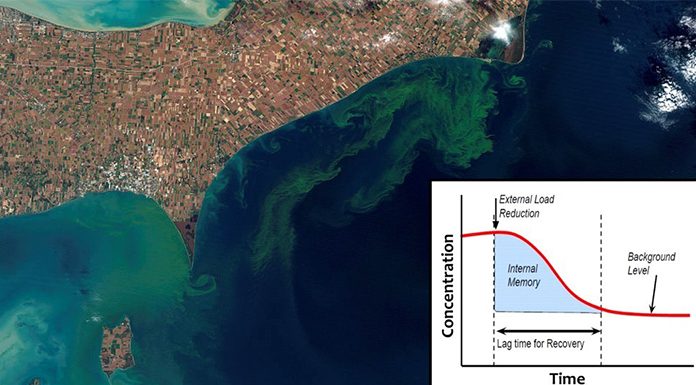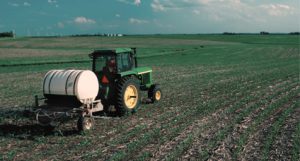
Agricultural nutrient legacies delay the recovery of healthy aquatic ecosystems, according to researchers from the University of Waterloo, Canada
Agriculture is a dominant source of nutrient emissions to the environment due to the widespread use of fertilisers as well as intensive livestock production. Research shows that excess nutrients applied to the landscape accumulate in soils, sediments and groundwater, leaving a long-term legacy that can negatively affect water quality for decades.1,2,3
Understanding the dynamic nature of agricultural nutrient legacies will allow us to develop more targeted and more efficient agricultural management practices that protect water quality and aquatic ecosystems.
Excessive nutrient emissions place rivers, wetlands, lakes and coastal areas at risk. From the Baltic Sea to North America’s Lake Erie, the proliferation of algae, driven by abundant nutrients, has become commonplace, leading to threats to human and aquatic ecosystem health.
The Legacies of Agricultural Pollutants (LEAP) project is a €1.6m, three-year research project that will assess the environmental and economic costs of the impacts of long-term nutrient legacies on water quality, and develop a unified framework to incorporate agricultural legacies and time lags into adaptive management strategies to protect water resources under changing climate and land use.4
LEAP brings together scientists from Canada, Sweden, Denmark and Portugal and is a deeply interdisciplinary project, combining a team of ecohydrologists, environmental (geo)chemists and economists, together with a range of stakeholders from government and civil society. LEAP is funded through the Joint Programming Initiative ‘Water Challenges for a Changing World’ (Water JPI) launched by the Council of the European Union.5
Nitrogen and Phosphorous
Nutrients are introduced into the environment via point and non-point sources. Through the continual building and upgrading of wastewater treatment plants, urban and industrial point sources of the nutrient elements nitrogen (N) and phosphorus (P) have been greatly reduced in western Europe and North America. As a result, diffuse agricultural non-point sources have become the dominant source of nutrient pollution in many of our watersheds.
Crops only take up a portion of the fertiliser applied to fields each year, with excess nutrients accumulating in the soils or leaching to groundwater, from which they can slowly make their way to nearby rivers and streams.
According to our estimates, even after fertiliser application stops, the release of legacy N and P continues for several decades.
Although the stockpiles of nutrients accumulating within the landscape may not be immediately apparent, their release over time contributes to the high levels of N and P that we observe in streams and rivers. Interest in nutrient legacies is gaining in importance as more effort and money are being invested in improving water quality, in particular through the implementation of better nutrient management practices. These include, for example, reducing fertiliser application rates, planting cover crops, installing riparian buffers, and practising conservation tillage.
Although these practices should in principle reduce the unwanted transport of nutrients to streams and groundwater, the expected improvements in water quality have been slow to materialise, and water quality targets have seldom been met. While the inability to meet water quality goals can be blamed on a variety of things, there is mounting evidence that nutrient legacies may be largely responsible for the long time lags between the implementation of agricultural best management practices (BMPs) and actual improvements in water quality.

Transatlantic learning
LEAP will determine how much N and P have accumulated within selected agricultural watersheds across Europe and Canada, and then make estimates of how long it will take for these legacies to be depleted, once BMPs are implemented. To meet these goals, we will first focus on a small group of reference watersheds, ranging in size from 1,000 to 15,000km2 and spanning a variety of socioeconomic and environmental settings, from the Mediterranean climate of the Mondego River Basin in Portugal to the sub-boreal landscapes of central Ontario in Canada, where global warming is causing a northward expansion of commercial forestry and agriculture.
Lessons learned from the reference watersheds in Canada and Europe will allow us to identify the dominant controls on nutrient accumulation within soils and groundwater, which in turn will inform the development of a dynamic model describing the build-up and remobilisation of legacy N and P in intensively managed agricultural landscapes.
Of particular interest is how the interplay between nutrient legacies, climate change and land use will affect nutrient loads to rivers and receiving water bodies in the foreseeable future. LEAP, however, will not only focus on environmental impacts, but also on economic costs – including future costs – stemming from nutrient legacies.
Although attempts have been made to quantify the costs associated with achieving improvements in water quality, economists have typically assumed simple, and instantaneous, cause-and-effect relationships between the implementation of a new BMP and the reduction in nutrient concentrations resulting from that implementation. However, to accurately assess the costs and benefits of particular management interventions, it is imperative that we have a better understanding of how long it will take to see the expected improvements.
By creating an integrated socioecological modelling platform, we will be able to link historical reconstructions and forward projections of agricultural N and P legacies in watersheds and their time-dependent impacts on water quality with analyses of the associated risks, costs and benefits.
Associated agriculture
The nutrients that end up in our rivers and lakes – today and in the future – have far-reaching effects on ecosystems, human health, and the economic wellbeing of surrounding communities. Nutrients feed nuisance and harmful algal blooms, which can cause the appearance of large ‘dead zones’ in lakes and coastal waters and make these waters unfit for swimming, fishing and drinking.
Such impacts have huge economic implications, with losses estimated to be on the order of billions of euros per year. The hydroeconomic approach taken by the LEAP project will allow us to propose more efficient and cost-effective approaches to mitigate the water quality impacts of watershed nutrient legacies, and to better balance the costs and benefits associated with such mitigation efforts.
The transatlantic LEAP consortium will be co-ordinated by the University of Waterloo, in partnership with the University of Copenhagen, Stockholm University and the University of Coimbra. With its focus on filling critical knowledge gaps about agricultural nutrient legacies and creating new assessment and prediction tools, LEAP will contribute to the overall Water JPI goal of strengthening transnational and transdisciplinary research and innovation aimed at reconciling agricultural productivity with clean water for human and ecosystem health.
References
- Van Meter, KJ, Basu, NB, Van Cappellen, P. (2017) Global Biogeochemical Cycles 31, doi: 10.1002/2016GB005498
2. Van Meter, KJ, Basu, NB, Veenstra, JJ, Burras, CL. (2016) Environmental Research Letters 11(3), doi: 10.1088/1748-9326/11/3/035014
3. Van Meter, KJ, Basu, NB. (2017) Environmental Research Letters, doi: 10.1088/1748/9326/aa7bf4
4. Website: uwaterloo.ca/leap
5. Website: www.waterjpi.eu









